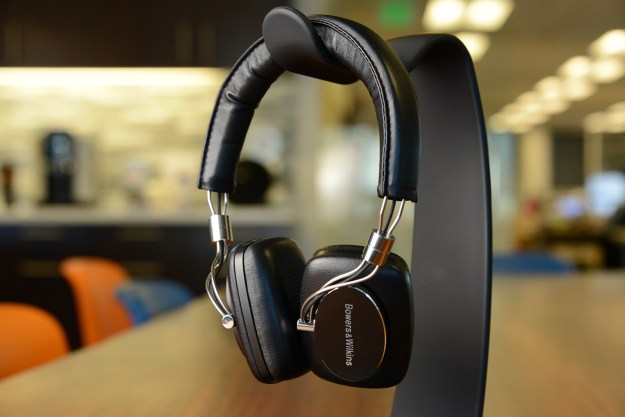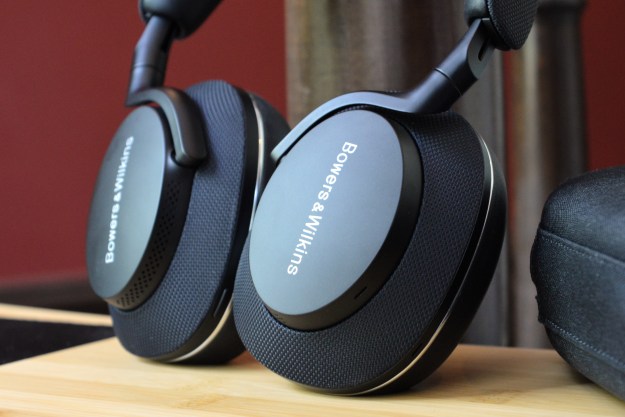
- Clear and powerful sound stage
- Solid detail in the upper register
- Rich and authoritative bass
- Stylish and suave as ever
- Comfortable
- Bass can get too heavy
- Acoustic instruments sound less than natural
- Controls are a little chintzy
- Pricey
Bowers & Wilkins burst onto the wireless audio scene last year with its first ever Bluetooth speaker, the T7. Displaying disruptive capabilities in both performance and functionality, the T7 proved, in impressive fashion, what today’s Bluetooth technology can do when placed in the right hands.
It was no surprise, then, to see B&W cut the cord on one of the brand’s notoriously plush and stylish headphones, the P5. Following popular entries like Sennheiser’s impressive (and expensive) Momentum Wireless series, the P5 Wireless ($400) aim to enter an elite group of Bluetooth cans that offer top-notch style, performance, and versatility, 100 percent cord-free. But, even with today’s best technology, crafting quality
Out of the box
Cut the cables on the regular P5 (actually, please don’t) and you’ll basically have the P5 Wireless. The headphones prudently stay true to their roots in design, brandishing curls of sterling aluminum along the earpieces, matched by ample padding cloaked in supple strips of rich leather. The earpieces extend from a light and malleable headband in smooth, fluid movements for a secure fit, and the only visual wireless attributes include a control strip on the right ear piece and a small power switch below with matching LED.
The included tote bag is stitched in a rich diamond pattern, covered with a slick magnetic flap that bears the Bowers & Wilkins logo in silver. Inside is a small pouch that houses a USB to micro-USB power cable and a conventional 3.5mm cable to plug the cans in if the built-in battery runs dry. As expected, the earpieces fold to lay flat in the bag for compact travel.
Features and design
Striking an aesthetic that’s both classic and chic, the P5 are an elegant addition to an exclusive club of premium
There’s some pleasant warmth added to instruments that will attract those who like a little ruddy color to their music.
Still, the P5 Wireless boast some intricate design traits unique to their maker. Users new to the B&W brand will note that there’s no readily available port for the accompanying 3.5mm cable. However, it’s all part of the minimalist plan: Pulling on the earpads releases the hold of strong magnets to reveal ports on the left side, alongside a clear view of the P5’s 40mm drivers.
Following that minimalist trend, the controls for the P5 include a simple three-button strip for volume +/-, pause/play, and song skip, accomplished by double or triple clicking the center key. The controls are easy to use, though the buttons feel a little cheap — in fact, the button for decreasing volume actually quit working on our review pair, though we’re guessing that’s an anomaly for the luxury brand. Sliding a power switch fires the headphones up, and holding it puts the
Speaking of pairing, the P5 minimalism goes a bit far on that end for our taste, allowing to pair with just a single device at a time so you can’t jump from a computer or tablet to a smartphone without some rigmarole. In addition, we had to reconnect the P5 to our device every time we turned it on — that’s a feature that can be convenient for those with multiple Bluetooth devices floating around, but considering that the P5 shut down after a few minutes of idle time, it can also be something of a hassle.
The headphones employ Bluetooth with aptX for improved sound quality from compatible devices (read: non-Apple products), and the advanced Bluetooth chip allows for as much as 17 hours on a charge, though in practice, we’d say that estimate is slightly inflated. Other specs for the
Comfort
The P5 Wireless offer plenty of cushion where it’s needed, and a fit that allows for real autonomy without any worries that they’ll slip or slide around. Our only real issue here is with the leather pads, which can make your ears a little sweaty on warmer days.
Audio performance
Contrary to the picture painted by their classic design, the P5 Wireless are not the kind of headphones crafted around the flat frequency response you might expect, celebrating balance over exuberance. In fact, they’re quite the opposite. These are a powerful set of cans, created for the sonic era that Beats built, with a rigid, yet authoritative bass department. Still, for the most part, the P5 Wireless manage to keep bass contained, carving out plenty of space that allows the upper registers to display plush detail, and fluid stereo movement for a striking overall performance.
And while stringed instruments like acoustic guitar and mandolin don’t quite exude the sweet, organic flavor you’ll get from top-tier competitors (like the aforementioned Sennheiser Momentum) there’s some pleasant warmth added to instruments that will attract those who like a little ruddy color to their music. The bass line on Paul Simon’s You Can Call Me Al is nothing shy of gorgeous, popping with a heavy punch that rings with all the texture of a real bass cabinet, while the horns on the tune are caramelized at the sustain, with a brilliant finish. And for those who like a little extra oomph, the drums at the intro track, The Boy in the Bubble, slam down at the lead-in with almost brutal authority.
The DT Accessory Pack
Up your game and the get the most out of your gear with the following extras, hand-picked by our editors:
Anker 2nd Gen Astro Mini 3200mAh Portable Charger ($10)
Garmin’s NuviCam LMTHD is backup camera accessible, but the product is sold separately. The BC 30 allows you to monitor behind as well as in front.
Headphone Hard Carrying Case ($14)
Increase your video and picture storage with this 32GB MicroSD card.
Apple Certified iPhone 6 Charging Case ($66)
To help keep you safe during a breakdown, this roadside assistance kit features warm fleece gloves, emergency candles, a folding shovel, an ice scraper, a whistle, and first aid supplies.
However, that flair for brutality can be a little much at times. The extra push in the upper bass tends to rewrite your catalog with longer sustain down below. The headphones certainly never fall into the muffled transgressions of so many hip-hop
Conclusion
If the Bowers & Wilkins P5 look like an Aston Martin, they sound like a muscled up Mustang. While the low end can get a little pushy for our ears, those seeking powerful, musical bass without sacrificing lucidity in the midrange and treble will certainly find that here.
Highs
- Clear and powerful sound stage
- Solid detail in the upper register
- Rich and authoritative bass
- Stylish and suave as ever
- Comfortable
Lows
- Bass can get too heavy
- Acoustic instruments sound less than natural
- Controls are a little chintzy
- Pricey
Editors' Recommendations
- Best Sony WH-1000XM5 deals: Save $70 on the wireless headphones
- Updating our Sony WF-1000XM5 review
- Bowers & Wilkins and McLaren launch special-edition Px8 headphones
- B&W’s flagship Px8 headphones cost way more than they were supposed to
- Edifier MP230 Hands-on Review: The pint-sized, retro Bluetooth speaker brings a vintage vibe








